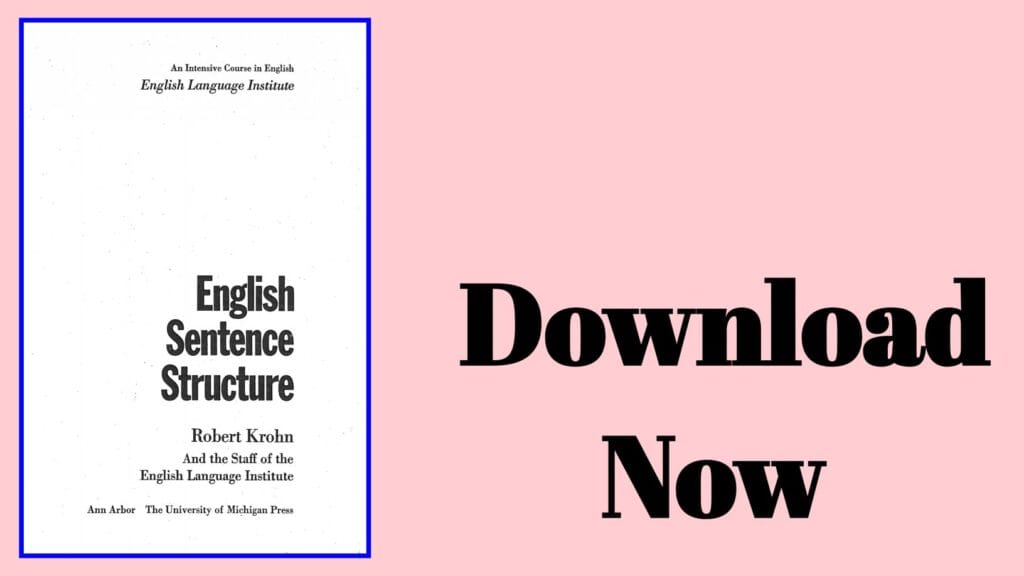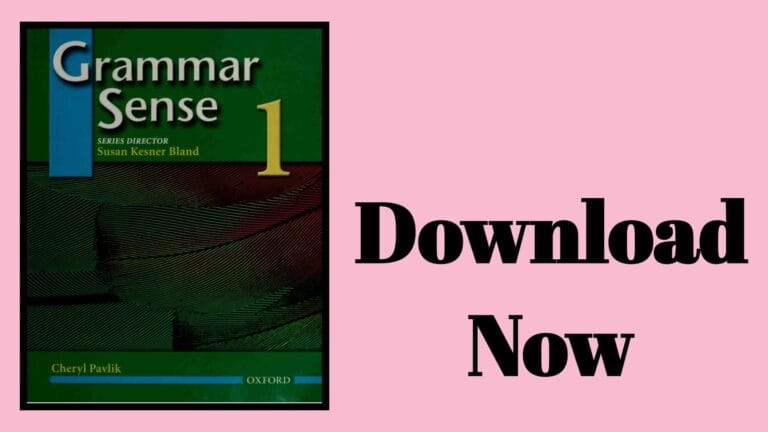
Describing the Book
“English Sentence Structure Download” is a book written by Robert Krohn on the the sentence structures of the English language and especially designed for the learners of English grammar. As the name suggests, the book is talking about the structures or patterns of sentences in English.
Sentence structures or patterns such as subject plus verb plus object, subject plus linking verb plus adjective or subject plus helping verb plus main verb are the grammar topics that have been covered in this book in great details. The book has got wonderful features that attract the learners of the English grammar.
Thereby, the author discusses several topics of English grammar such as basic question sentence structures, phrase structures, clause structures, conditional sentence structures, modal verb sentence structures, relative clauses and more like them have been detailed in the book.
This particular book features 30 amazingly and beautifully crafted lessons that are related to different grammar topics such as phrase, clause, modal verbs, conditionals, parts of speech. One of the most appealing features of the book is that it has dedicated one complete lesson to the review of the previous chapters after every 10 lessons.
Who’re The Targeted Readers?
The contents of the book suggest that the book is not specifically written for any particular level students; that is, no specific readers are targeted. However, the readers should have the basic knowledge about the English language and grammar. Therefore, the targeted readers of the book are those learners of the English language who are at the intermediate level of grammar.
The readers are suggested to go through the contents of the book so that they can guess what to expect from the book and learn according to their needs. The readers must make sure to visit the book on a daily basis once they’ve chosen to read this book for learning grammar.
Advantages of Reading The Book
The author of the book has got amazing talent of teaching English grammar though his unique teaching method. He has ensured to make the lessons interesting and engaging by choosing the relevant contents and writing them beautifully. He starts his lesson 1 with simple sentence structures such as statements and question sentence structures.
The book has touched on almost every essential grammar topics. The most of them are tenses, parts of speech, modal verbs, phrases, clauses, wh questions, common structures, making comparisons and more like them. The most striking feature of the book is that it has lesson to review all the previously discussed topics.
The Table of Contents
Lesson 1
A. Be: am, are, is
Statements and questions: It is green. Is it green?
Contractions: It’s green. It isn’t green.
Short answers: Yes, it is.
B. Singular and plural noun phrases
Lesson 2
A. Simple present tense with verbs other than be
Statements: He works.
Questions with do, does: Does he work?
Short answers: Yes, he does
B. Single-word adverbs of frequency: always, usually, often, etc.
Lesson 3
A. Adverbials of place and time
B. Past tense of be in statements, questions, and short answers: He was here. Was he here? Yes, he was
C. Past tense of regular verbs
Lesson 4
A. Wh-questions: who, what, where, when
B. Present progressive: He is writing
C. Using adjectives and nouns to modify nouns: small class, grammar class
Lesson 5
A. Be + going to to indicate future time: He is going to sing
B. Negative statements: He isn’t here. He didn’t come
C. Negative statements with single-word adverbs of frequency: He isn’t always here. He doesn’t always study
D. Some and any
Lesson 6
A. The articles: the, a, an
B. Count and noncount nouns: a pencil; some ink
C. Quantity expressions: much, many, a few, etc.
D. Demonstratives: this, that, these, those
E. Possessives: my, your, his, etc.
Lesson 7
A. Requests: Please read the book. (Would you . . .; let’s . . .)
B. Irregular nouns: man, men; people
C. The noun substitute one
D. The use of other and another
E. The object forms of pronouns: me, him, them, etc.
Lesson 8
A. Verb and indirect object: Give her a book; Give a book to her
B. Past tense forms of irregular verbs: eat, ate; give, gave
Lesson 9
A. Adverbs of manner: correctly, well, etc.
B. Noun phrase + modifier: the chair near the door
C. Wh-questions: Who does Mary see? Who sees Mary?
Lesson 10
Review of Lessons 1 to 9
Lesson 11
A. Modal auxiliaries: will, can, etc.
B. Statement connected with and . . . too, and . . . either, and but
Lesson 12
A. Verb + preposition + object: He called on them.
Verb + particle + object: He called them up
B. Adverbials of purpose: He went to buy some books
C. Adverbials of means: He came by plane.
Adverbials of instrument: He wrote with a pen
Lesson 13
A. Verb + to + verb: George wants to go.
Verb + noun phrase + to + verb: George wants John to go
B. Be + adjective + to + verb: This is easy to learn
C. Very, too, enough
Lesson 14
A. Some uses of it in subject position: It’s early. It’s easy to understand this lesson
B. The expletive there: There is a book on the table
C. Possessive of and -’s: The legs of the table. The dog’s legs
D. Possessive pronouns: mine, yours, etc.
E. Whose
F. One and ones
Lesson 15
Expressions of Comparison:
A. the same as, different from, like the same . . . as, as . . . as
B. more . . . than, -er than
C. the most, the . . . -est
Lesson 16
A. Embedded statements: I know that he lives here
B. Embedded wh-clauses: I know who lives here
Lesson 17
A. Relative clauses
B. for, during, when, while, before, after, until
Lesson 18
A. The present perfect: have studied
B. The present perfect progressive: have been studying
C. The past perfect: had studied
D. Short answers: Yes, I have; No, I haven’t
E. Irregular verbs: go, went, gone, etc.
Lesson 19
A. Passive sentences: The letters were written
B. The use of still, anymore, already, and yet
C. Past participles as modifiers: John is interested
D. Adjective + preposition combinations: interested in music, excited about music
Lesson 20
Review of Lessons 11 to 19
Lesson 21
A. Verb + Noun Phrase + Verb: See him go
B. Wish sentences: I wish they knew
C. Wh-word + to + verb: They decided when to go
Lesson 22
A. must have, might have, should have, could have
B. must have with progressive forms: must have been going
C. Short answers: Did they go? They must have
D. Wish sentences in the past: I wish you had visited them
Lesson 23
A. Subordinators: if, unless, because, although, whether, whenever
B. because of, in spite of, regardless of
Lesson 24
A. Conditional Sentences:
If he knows the answer, he will tell her.
If he knew the answer, he would tell her.
If he had known the answer, he would have told her
Lesson 25
A. so . . . that: so busy that he can’t go, such . . . that, such a busy man that he can’t go
B. Negative questions: Isn’t the teacher here?
C. Tag questions: John is here, isn’t he?
LESSON 26
A. self pronouns: myself, yourself, etc.
B. Verb expressions in -ing after other verbs: I enjoyed singing
LESSON 27
A. Nouns used as complements after direct objects:
They elected Kennedy president.
B. Adjectives used as complements after direct objects:
He pushed the door open.
C. Noun + -ing verb expressions used as direct objects:
He watched the boys playing.
LESSON 28
A. Verb expressions in -ing functioning as noun phrases:
Traveling is fun.
B. Verb expressions in -ing functioning as subordinate clauses:
Sitting in a chair, he watched TV.
LESSON 29
A. Conjunctions: and, but, or and sentence connectors:
however, therefore, also, etc.
B. Adverbial expressions of time and place in sentence initial position:
At nine o’clock we have class.
C. Summary statements: In other words,
LESSON 30
Review of Lessons 21 to 29


